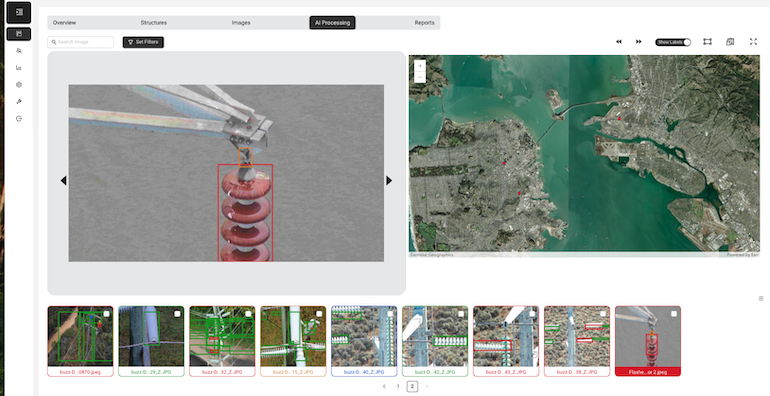 As wildfires continue to rage across Canada and other environmental factors threaten 24/7 power access for residential and business consumers alike, AI is answering the call to proactively protect the grid.
As wildfires continue to rage across Canada and other environmental factors threaten 24/7 power access for residential and business consumers alike, AI is answering the call to proactively protect the grid.
AI software companies, like Buzz Solutions, are helping utilities modernize grid inspections, enhance storm resilience, and reduce wildfire risk through cutting-edge predictive technology, for example.
AI Modernizes Grid Management

Kaitlyn Albertoli, CEO and co-founder, Buzz Solutions
“Utilities are adopting AI in many areas to modernize and manage the grid,” explained Kaitlyn Albertoli, CEO and co-founder of Buzz Solutions. “In load forecasting, AI models analyze weather, customer usage, and distributed generation to more accurately predict demand. This helps utilities balance supply and demand while managing the increased use of renewables, electric vehicles, and storage assets.”
Albertoli further explained, “AI also plays a key role in how utilities inspect and maintain their infrastructure. The grid includes hundreds of thousands of miles of transmission and millions of miles of distribution lines across North America. Utilities have traditionally relied on manual inspections. They are now increasingly using AI to process the visual data utilities collected from drones, helicopters, and fixed wing aircraft. Drones especially are helping to quickly and accurately detect corrosion, broken hardware, vegetation encroachment and other issues,” highlighted Albertoli.
“With AI, utilities can more easily scale their inspections as their amount of visual data increases exponentially, and fix problems before they turn into failures, which helps improve grid reliability and resilience,” stated Albertoli.
Highlighting AI efficiency Albertoli said, “Historically, in manual analysis, utilities are looking for anomalies or defects, which will warrant maintenance,” remarked Albertoli. “With the use of AI, utilities can also inventory assets and track the health of good components more effectively. This lends to a better understanding of where the utility can upgrade and modernize their infrastructure to get the maximum result.”
Visual data and predictive analytics
AI is the workhorse that meets the challenge of turning vast amounts of collected data “into useful information quickly and accurately,” said Albertoli. “Our platform, PowerAI, processes imagery from drones, helicopters, fixed wing aircraft, static cameras, and ground inspections and applies computer vision to detect equipment anomalies.”
Albertoli explained, “We identify things like corrosion, damaged insulators, missing hardware, structure defects, vegetation near lines, and thermal hotspots that signal overheating. The system not only flags problems but also prioritizes which issues carry the highest risk of failure. This helps crews focus on repairs that prevent immediate outages and safety incidents, while tracking lower-risk anomalies for more frequent monitoring and inspections.”
Added Albertoli, “Beyond transmission and distribution inspections, we also help utilities monitor their substations with our PowerGUARD solution. Substations are critical assets that face both physical security and operational safety risks. PowerGUARD uses AI to analyze video feeds in near real time. It detects unauthorized access by vehicles or individuals, monitors for safety incidents like arc flashes or fires, and alerts operators to thermal issues or equipment malfunctions.”
A Canadian Example
“In Canada, we have worked with Newfoundland Power and the Electric Power Research Institute (EPRI) to inspect their transmission and distribution infrastructure,” shared Albertoli. “Before using our platform, crews needed about 20 minutes to inspect each pole. With our system they completed inspections in about 2 minutes per pole. That allowed the utility to scale inspections, cover more ground, and catch issues before they reached risk of critical failure.”
Can AI help utilities become more resilient as environmental risks increase?
“Environmental risks create some of the biggest challenges for utilities today,” replied Albertoli. “Wildfires, hurricanes and other storms, droughts, and extreme heat are all tied to issues around aging grid infrastructure globally. Grid sparked wildfires alone have led to massive environmental damage and financial liabilities for utilities. AI gives utilities the ability to spot risks early and act before failures or problems happen,” said Albertoli.
Albertoli added, “As more renewables such as solar and wind, electric vehicles, and distributed energy resources connect to the legacy grid, AI-powered inspections become even more important to maintain safety and stability. AI gives utilities real-time visibility into many aspects of their infrastructure and helps them adapt as the grid evolves.”
Growing Energy Demands
“While heavy demand for more electricity is putting significant strain on the grid, with things like electrification efforts, EVs and data centers,” said Albertoli, “utilities can also use AI to build stronger, more resilient systems that can handle both climate challenges and growing energy demand.”

Vikhyat Chaudhry, CTO/COO, co-founder of Buzz Solutions
I asked how Buzz Solutions offsets its energy use with AI, to which Vikhyat Chaudhry, CTO/COO and co-founder of Buzz Solutions, replied, “Buzz leverages scalable, cloud-native infrastructure … AWS, GCP or Azure [as examples] to run its AI models, with emphasis on optimized AI inference and training cycles. Models are trained efficiently, and inference workloads are batch processed or edge-deployed to reduce compute waste.” Chaudry added, “Using cloud regions powered by renewables where possible, workloads are directed to data centers that run on clean or carbon-neutral energy.”
Chaudry elaborated, “Buzz’s core AI offering indirectly offsets its energy use by helping utilities prevent energy losses … from defects/faults, fires, or inefficient equipment [for example]. Identifying issues that cause energy leakage, such as transformer faults, vegetation risks, or equipment overheating. Enabling faster maintenance cycles, reducing the need for energy- and fuel-intensive manual inspections. In effect, every structure Buzz helps monitor more efficiently contributes to greater energy savings across the grid and often orders of magnitude larger than Buzz’s own energy use.”
-30-
Related:
New Fire Tech Tools in the Fight as Wildfire Season Rages in Canada



